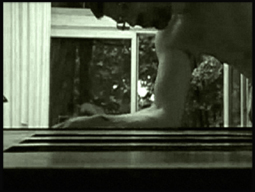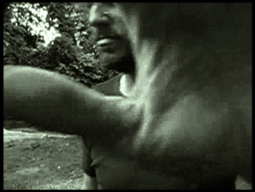
HOME
ABOUT
ASK US
COLLECTION
DIGITAL COLLECTION
EXHIBITS
SUPPORTGCRC
CONTACT US
PRESS
VIDEOS
Recorded Interview
Seth Widman and Michel
Antoine Seurat about: A rainy day with George Cup in
Easthampton, 1978
 audiofile recorded on WQXR on march 17. 2011
audiofile recorded on WQXR on march 17. 2011
Michel Antoine Seurat, born in Paris in 1940, is a French film
editor and lived from 1970 to 1980 in New York City. Today
Seurat lives in Paris. In 1977 Seurat made a short film about
George Cup in his studio in Easthampton. In February 2011 he
discovered that the George Cup Research Center is bringing back
the life and work of George Cup & Steve Elliott to public mind.
The last existing copy of this film is now in possession of the
Research Center and displayed to the public for the first time.
S.W. Mr. Seurat, when we learned you did a short film
about George Cup & Steve Elliott in 1978 in their studio in
Easthampton, the Stuff of the Research Center was surprised and
glad about this discovery. Nobody had any knowledge about this
film.
M.S. Maybe because it was never displayed in a Gallery or
Museum. In fact I didnít wanted anyone to see this little film
after what had happened during the recording in 1978 and by the
consequences I had to follow by the orders of George Cup. So I
simply forgot about it and remembered it, when I saw one of the
animation films made by George & Steve Ė you can say it was
Steve who did the work on that films Ė at the Centre George
Pompidou in Paris in January this year. It was like an old door
opens slowly to the past with a strange noise. You must know I
left the States in 1980 and returned to Paris. And all my
thoughts about being a filmmaker were left behind too. So I
didnít follow the career of George Cup in the years after and I
was surprised about what I learned when I started to research
after seeing that animation film The connection between form and
sound # 15 that is also made in 1978, if I am right. And itís a
beautiful peace. I remember that in 1978 and the year before,
when we met the first time, George and Steve had been very busy,
a lot of exhibitions and It was hard to catch them. Thatís one
of the reasons why it took me nearly one year to get this
meeting with him in Easthampton.
S.W. The private material of the life of George Cup &
Steve Elliott has nearly vanished. For the Research Center the
discovery of your film is very interesting and valuable. Also
the form of the film is quite unique. There is no spoken
comment, no original sound, except in the beginning on the drive
to Long Island. Is that why you choose do start the film with
three text frames Ė the preface by the director?
M.S. Yes, in the preface I explained why the film looks like it
looks and the difficulties I had with George during the filming.
He was very unpleasant in the beginning and at the end. In the
middle he was quite different, you can see that when plays
around with his own eight millimetre camera. So it all started
strange. When we arrived he didnít wanted to let us in, cause he
had forgotten our meeting. He just came out, said hello, Steve
is not present and that he is working, so we had to wait or come
back another day. It was really strange. But what could we do?
So we went in the park behind the studio. A beautiful park with
old trees and we started to make some shots. But it started to
rain, slowly but than it turned into a little storm, and George
still didnít wanted to let us in. So we took cover under an old
tree and continued recording. It was somehow very beautiful too,
but I was close to stop this whole undertaking. And then after
the weather cleared up George was in a better mood. And he
explained us the rules for his studio. No talking and all that
stuff and I thought this isnít going to work, but my friend and
assistant Pierre Moulin convinced me to stay. So we agreed.
You mentioned the form of the film and I want to say something
about that. The music is from Bill Evans. Itís the LP From Left
to Right from 1969. George gave it to me with the comment to use
this only for the background sound. I wasnít allowed by his
statement to use the original sound, which I hardly agreed to,
but I gave in. In that time I didnít want to have any trouble
with him, maybe cause of his temper, that was hardly to control.
So I choose to give it a try and it fits in perfectly I think,
today. He wasnít wrong in saying that the film should speak for
itself. And if you follow the line of the film and what happened
than the music really make sense. You can call it a happy
accident.




Filmstills from A rainy day with George Cup in Easthampton,
1978 by Michel Antoine Seurat
S.W. You marked out the temper of George Cup. During the
film we can see how his mood changes. How was the day under that
aspect?
M.S. Well it was unforeseeable how he would react on any issue.
For example the moment when he played with his eight millimetre
camera. It was after he made a pause and had coffee, that he
suddenly took his camera and started to record us. I have never
seen the results of that, maybe there wasnít even a film in the
camera and he was making fun of us. Anyway, he really was joking
around, following Pierre with his camera when suddenly he
stopped it and changed in what I would say, a professional
behaviour. Like he had realised that this is not an adequate
thing to do with us Ė in his way of thinking.
S.W. It is very sad that this beautiful shots at the
studio and in the park of Easthampton are in such sad condition.
What happened to the original material? This is the last
existing copy you said.
M.S. I am very sorry for that too. I really cant recall where I
put the original material. I guess it stayed in New York when I
left for Paris in 1980. Itís a miracle to me that I could found
this copy that we can see now. Its low quality but as you said,
itís the only existing copy that remains. To be honest, I hadnít
thought of all this since the 1980īs, and I still wouldnít if I
hadnít seen the animation film at the CGP.
S.W. You said you were surprised of what you learned
about George Cup and Steve Elliott. So you had no idea of what
had happened in 1986 when George was arrested for murder and in
2009 when George died?
M.S. No I had no idea. It really took me by surprise. Well we
talked about his temper, so my first impression, when I learned
that he was imprisoned for murdering Steve, I thought by myself
that it would be possible. So itís a strange mixture of emotions
I had, reading about what happened. Especially the fact that he
was innocent and was released from prison in 2009 as a free man.
That he was quiet about his innocence all the years is a miracle
to me. I have no explanation. He (George) wasnít a bad person.
He was just hard to take.
S.W. The object George is working on in your film is
part of the Lightsquare series, it looks like the Lightsquare #
20 from 1970. Did George said anything about this peace?
M.S. (laughs) I thought the same when I saw what he was working
on. And I asked him about it, but that was the only question I
did asked him. He said that the Collector had brought it to him
for restoration, and maybe that was also a reason for his bad
mood, cause he was really pissed about it Ė sorry but there is
no other word for a better description. He had to remove the
whole front to put new neon lights in it, and I think he did the
whole thing new. Thatís what it looked like to me. And he was a
fast worker, really fast. But he wasnít satisfied with the
result, maybe the bulbs or something else, the quality of the
light was wrong, he showed us the door shortly after he had
finished the work. That was the last time I saw him. We took our
equipment and drove back to New York.
S.W. In the end of the film there is a short passage where you
are visible in front of the camera, shaking your head. Was this
experience with George Cup one of the reasons for you to quit
working as a film maker?
M.S. No. In the 1970īs I tried to make my own films and there
are some interesting results, but in the end I realised that my
work as a film editor was more rewarding for me. There is always
a point in life where you have to make difficult decisions, that
was a decision I had to make in 1980 when I retuned to France.
And I donít regret it.
S.W. Thank you for your time and this private look on
the life of George Cup.





